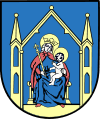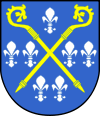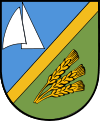Iława
| Iława | |||
|---|---|---|---|
|
Town view | |||
| |||
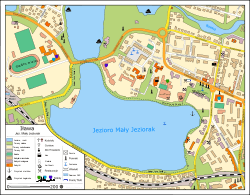 | |||
 Iława | |||
| Coordinates: 53°35′47″N 19°33′56″E / 53.59639°N 19.56556°E | |||
| Country |
| ||
| Voivodeship | Warmian-Masurian | ||
| County | Iława County | ||
| Gmina | Iława (urban gmina) | ||
| Established | 1305 | ||
| Town rights | 1305 | ||
| Government | |||
| • Mayor | Włodzimierz Ptasznik | ||
| Area | |||
| • Total | 21.88 km2 (8.45 sq mi) | ||
| Highest elevation | 150 m (490 ft) | ||
| Lowest elevation | 100 m (300 ft) | ||
| Population (2010) | |||
| • Total | 32,276 | ||
| • Density | 1,500/km2 (3,800/sq mi) | ||
| Time zone | CET (UTC+1) | ||
| • Summer (DST) | CEST (UTC+2) | ||
| Postal code | 14-200 to 14-210 | ||
| Area code(s) | +48 89 | ||
| Car plates | NIL | ||
| Website | http://www.ilawa.pl | ||
Iława [iˈwava] (German: Deutsch Eylau (![]() listen)) is a town in northeastern Poland with 32,276 inhabitants (2010). It is situated in the Warmian-Masurian Voivodeship (since 1999); previously it was in Olsztyn Voivodeship (1975–1998). It is the capital of Iława County.
listen)) is a town in northeastern Poland with 32,276 inhabitants (2010). It is situated in the Warmian-Masurian Voivodeship (since 1999); previously it was in Olsztyn Voivodeship (1975–1998). It is the capital of Iława County.
History
The town was founded in Prussia in 1305 and is documented in a manuscript by Luther von Braunschweig in 1317. It was built on the Eylenz (Iławka) River between Lakes Geserich (Jeziorak) and Eylenz (Iławskie). This location makes it a popular vacation area. The town was under the jurisdiction of the komtur of Christburg (Dzierzgoń) and since 1340 under Osterode (Ostróda). In 1457 it was sold to King Casimir IV Jagiellon of Poland during the Thirteen Years' War between the cities of Prussia and Poland on one side and the Teutonic Order on the other.
As Deutsch Eylau, the town became part of the Duchy of Prussia in 1525 and the Kingdom of Prussia in 1701. Administered within the new province of West Prussia in 1773, it became part of the German Empire in 1871.
In 1862 the Oberland Canal (Elbląg Canal) was built between Elbing (Elbląg) and Eylau by engineer Georg Steenke, which enabled the inland town to transport bulk of lumber, farm products, and other goods north to Elbing and the Baltic Sea. This was superseded ten years later by rail transport, when the Thorn (Toruń)-Insterburg (Chernyakhovsk) railway line was constructed.
The East Prussian plebiscite of 1920 ostesibly allowed the residents to cast votes either in favor of remaining in Germany or becoming a part of Poland. The vote was largely boycotted by ethnic Poles, amid in mass persecution of Polish activists by the German side, going as far as engaging in regular hunts and murder against them to influence the vote. Ultimately the town voted to remain in Germany by 4,746 to 235 votes. It became part of Regierungsbezirk West Prussia in the Province of East Prussia.
After World War II the region was placed under Polish administration by the Potsdam Agreement under territorial changes demanded by the Soviet Union. Most Germans fled or were expelled and replaced with Poles expelled from the Polish areas annexed by the Soviet Union.
Notable residents
- Richard Altmann (1852–1900), pathologist
- Erich Diestel (1892–1973), Wehrmacht general
- Friedrich Karst (1893–1975), general
- Gustav Wilke (1898–1977), Fallschirmjäger general
- Helmuth Stieff (1901–1944), Wehrmacht general and resistance fighter
- Joachim Meichssner (1906–1944), Wehrmacht officer and resistance fighter
- Paul Semrau (1915–1945), Luftwaffe pilot
- Catharina Klein (1861–1929), flower painter
Gallery
 Gothic church in Iława
Gothic church in Iława.jpg) High school in Iława
High school in Iława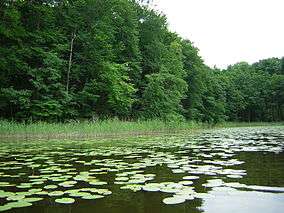 Jeziorak lake
Jeziorak lake- View from space
 "Kaiserstraße", ca. 1910
"Kaiserstraße", ca. 1910
International relations
Twin towns — Sister cities
Iława is twinned with:
External links
| Wikimedia Commons has media related to Iława. |
Coordinates: 53°36′N 19°34′E / 53.600°N 19.567°E

